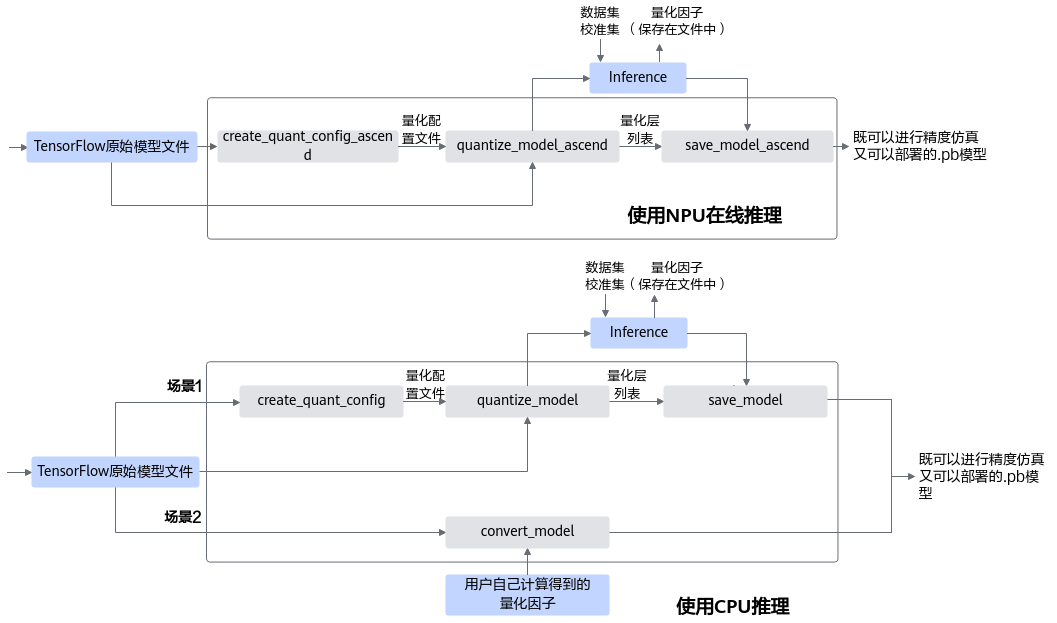本节详细介绍训练后量化支持的量化层,接口调用流程和示例。
训练后量化支持量化的层以及约束如下,量化过程请参见样例列表。
|
支持的层类型 |
约束 |
备注 |
|---|---|---|
|
MatMul:全连接层 |
transpose_a=False, transpose_b=False,adjoint_a=False,adjoint_b=False |
- |
|
BatchMatMul/BatchMatMulV2 |
adjoint_a=False,adjoint_b=False |
- |
|
Conv2D:卷积层 |
- |
weight的输入来源不含有placeholder等可动态变化的节点,且weight的节点类型只能是const。 |
|
DepthwiseConv2dNative:Depthwise卷积层 |
dilation=1 |
|
|
Conv2DBackpropInput:反卷积层 |
dilation=1 |
|
|
AvgPool:平均下采样层 |
- |
- |
接口调用流程
训练后量化接口调用流程如图1所示:
蓝色部分为用户实现,灰色部分为用户调用AMCT提供的API实现,用户在TensorFlow原始网络推理的代码中导入库,并在特定的位置调用相应API,即可实现量化功能。工具使用分为如下两种场景,本手册重点介绍使用NPU在线推理场景。使用TensorFlow CPU推理的详细操作请参见训练后量化。
- 使用NPU在线推理:
- 用户首先构造TensorFlow的原始模型,然后使用create_quant_config_ascend接口生成量化配置文件。
- 根据TensorFlow模型和量化配置文件,即可调用quantize_model_ascend接口对原始TensorFlow模型进行优化,修改后的模型中包含了量化算法,用户使用该模型借助AMCT提供的数据集和校准集,在NPU环境中进行在线推理,可以得到量化因子。
其中数据集用于在NPU环境中对模型进行推理时,测试量化数据的精度;校准集用来产生量化因子,保证精度。
- 最后用户可以调用save_model_ascend接口保存量化后的模型,该模型可在NPU环境中部署。
- 使用TensorFlow CPU推理:
- 场景1:
- 用户首先构造TensorFlow的原始模型,然后使用create_quant_config接口生成量化配置文件。
- 根据TensorFlow模型和量化配置文件,即可调用quantize_model接口对原始TensorFlow模型进行优化,修改后的模型中包含了量化算法,用户使用该模型借助AMCT提供的数据集和校准集,在TensorFlow CPU环境中进行推理,可以得到量化因子。
其中数据集用于在TensorFlow环境中对模型进行推理时,测试量化数据的精度;校准集用来产生量化因子,保证精度。
- 最后用户可以调用save_model接口保存量化后的模型,该模型可在TensorFlow CPU环境中进行精度仿真。
- 场景2:
如果用户不使用场景1中的接口,而是用自己计算得到的量化因子以及TensorFlow原始模型,生成量化模型,则需要使用convert_model接口完成相关量化动作。
- 场景1:
调用示例
训练后量化主要包括如下几个步骤:
- 准备训练好的模型和数据集。
- 在原始TensorFlow环境中验证模型精度以及环境是否正常。
- 编写训练后量化脚本调用AMCTAPI。
- 执行训练后量化脚本。
- 在原始TensorFlow环境中验证量化后仿真模型精度。
如下流程详细演示如何编写脚本调用AMCTAPI进行模型量化。

- 如下示例标有“由用户补充处理”的步骤,需要用户根据自己的模型和数据集进行补充处理,示例中仅为示例代码。
- 如下示例调用AMCT的部分,函数入参请根据实际情况进行调整。
- 导入AMCT包,调用set_logging_level接口设置日志级别。
1 2
import amct_tensorflow as amct amct.set_logging_level(print_level="info", save_level="info")
- (可选,由用户补充处理)建议使用原始待量化的模型和测试集,基于TensorFlow在NPU环境下在线推理,验证环境、推理脚本是否正常。
执行该步骤时,需要注意如下两点:
- 推荐执行该步骤,确保原始模型可以在NPU完成推理且精度正常,如果该步骤无法完成,则将无法进行量化操作;如果该步骤的推理精度不满足要求,则后续量化精度结果将不可信。
- 执行该步骤时,可以使用部分测试集,减少运行时间。
1user_do_inference_on_npu(ori_model, test_data)
- (由用户补充处理)根据原始模型user_model.pb,准备好图结构tf.Graph。
1 2
ori_model = 'user_model.pb' ori_graph = user_load_graph(ori_model)
- 调用AMCT,量化模型。
- 生成量化配置。
1 2 3 4 5
config_file = './tmp/config.json' skip_layers = [] amct.create_quant_config_ascend(config_file=config_file, graph=ori_graph, skip_layers=skip_layers)
- 修改图,在图中插入量化相关的算子。
1 2 3 4 5 6 7
record_file = './tmp/record.txt' user_model_outputs = ['user_model_outputs0', 'user_model_outputs1'] calibration_graph, calibration_outputs = amct.quantize_model_ascend( graph=ori_graph, config_file=config_file, record_file=record_file, outputs=user_model_outputs)
- (由用户补充处理)使用修改后的图在校准集上做在线推理,找到量化因子。
- 校准集及其预处理过程数据要与模型匹配,以保证量化的精度。
- 量化后图的calibration_graph输出为calibration_outputs,在线推理时都要执行。
1user_do_inference_on_npu(calibration_graph, calibration_outputs, calibration_data)
- 保存模型。
1 2 3 4 5
quant_model_path = './results/user_model' amct.save_model_ascend(pb_model=ori_model, outputs=user_model_outputs, record_file=record_file, save_path=quant_model_path)
- 生成量化配置。
- (可选,由用户补充处理)使用量化后模型user_model_quantized.pb和测试集,在TensorFlow CPU环境下推理,测试量化后的仿真模型精度。
使用量化后仿真模型精度与2中的原始精度做对比,可以观察量化对精度的影响。
1 2
quant_model = './results/user_model_quantized.pb' user_do_inference_on_cpu(quant_model, test_data)
